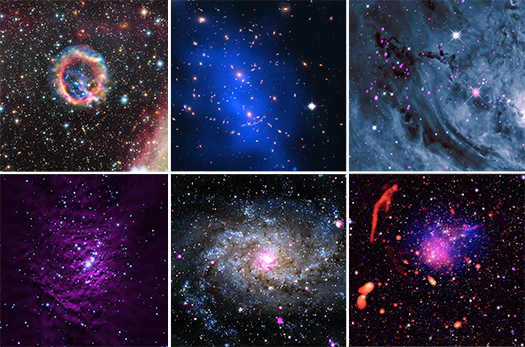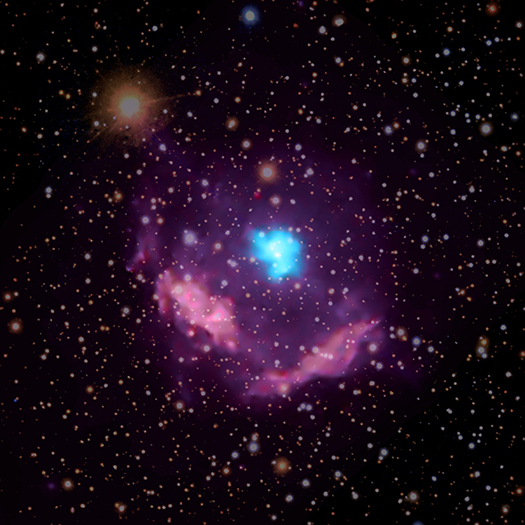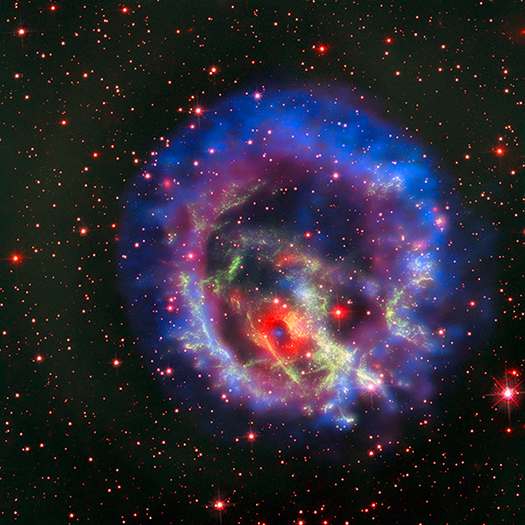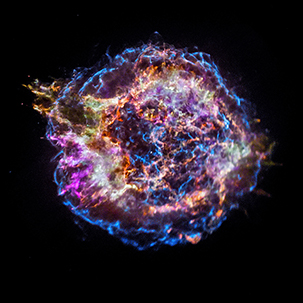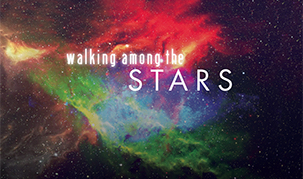Supernovas & Supernova Remnants
The Latest Look at "First Light" from Chandra
Your browser does not support the video tag.
Credit: X-ray: NASA/CXC/RIKEN/T. Sato et al.; Optical: NASA/STScI
Located about 11,000 light-years from Earth, Cas A (as it's nicknamed) is the glowing debris field left behind after a massive star exploded. When the star ran out of fuel, it collapsed onto itself and blew up as a supernova, possibly briefly becoming one of the brightest objects in the sky. (Although astronomers think that this happened around the year 1680, there are no verifiable historical records to confirm this.)
The shock waves generated by this blast supercharged the stellar wreckage and its environment, making the debris glow brightly in many types of light, particularly X-rays. Shortly after Chandra was launched aboard the Space Shuttle Columbia on July 23, 1999, astronomers directed the observatory to point toward Cas A. It was featured in Chandra's official “First Light” image, released Aug. 26, 1999, and marked a seminal moment not just for the observatory, but for the field of X-ray astronomy. Near the center of the intricate pattern of the expanding debris from the shattered star, the image revealed, for the first time, a dense object called a neutron star that the supernova left behind.
"Journey Through an Exploded Star" Opens
A new way to interact and explore Cassiopeia A, the remains of an exploded star, has launched. The press release below outlines this novel initiative between the Smithsonian Center for Learning and Digital Access and the Chandra X-ray Center. Led by Chandra’s Kimberly Arcand, this project allows you to watch, interact, or learn about this supernova remnant while delving into astrophysics, computer science, and more.
This online interactive version of Cas A (as it’s referred to) is one latest milestone with Chandra. Cas A was the “First Light” image that Chandra observed just weeks after being launched into space in 1999. In the nearly twenty years since, Chandra has repeatedly observed Cas A, revealing new secrets about this object from the neutron star at its center to the elements of life it has expelled.
A decade ago, a team of scientists and image processors came together and created the first-ever three-dimensional model of Cas A. Now, this 3D model enters a new phase with the launching of "Journey Through an Exploded Star"” We hope you will explore with us.
Chandra Serves up Cosmic Holiday Assortment
This is the season of celebrating, and the Chandra X-ray Center has prepared a platter of cosmic treats from NASA's Chandra X-ray Observatory to enjoy. This selection represents different types of objects — ranging from relatively nearby exploded stars to extremely distant and massive clusters of galaxies — that emit X-rays detected by Chandra. Each image in this collection blends Chandra data with other telescopes, creating a colorful medley of light from our Universe.
Angle Matters: A New Perspective on Neutron Star Collisions Solves an Old Mystery

Eleonora Troja
We are very pleased to welcome Eleonora Troja as our guest blogger. She is an associate research scientist at the University of Maryland, College Park, with a joint appointment at NASA Goddard Space Flight Center. She divides her time between her research on colliding neutron stars, directing the Swift Guest Investigator Program, and her three-year-old daughter, Bianca.
A year ago, on October 16th 2017, an amazing discovery was announced. GW170817, a collision of two neutron stars seen through gravitational waves and light, had realized the perfect union of two worlds. At the press conference organized by the National Science Foundation, a journalist asked an important question to the panelists: “Hadn’t we seen similar events before?” In that moment my mind ran back to an unusual gamma-ray burst, GRB150101B, localized by NASA’s Swift satellite nearly three years earlier.
GRB150101B was a flash of gamma-ray radiation that lasted for less than a fraction of a second. It was one of the weakest explosions ever seen with Swift, yet it was very luminous in X-rays and for a very long time. This was so unusual that Swift scientists were not sure whether the burst was a gamma ray burst (GRB) or another type of weird explosion, and dubbed it with a dual name GRB 150101B / SwiftJ123205.1-1056. I asked that NASA’s Chandra X-ray Observatory observe this object and help us unravel the mystery of its nature. Chandra revealed that there were two sources of X-ray light, not resolved by the Swift observations. A bright X-ray source was located at the center of the galaxy, probably indicating the presence of a supermassive black hole. Next to it, Chandra discovered a weaker X-ray signal coming from GRB150101B. At the same position, telescopes caught a glow of visible light which quickly faded away.
Milky Way's Youngest Pulsar Exposes Secrets of Star's Demise
Scientists have confirmed the identity of the youngest known pulsar in the Milky Way galaxy using data from NASA's Chandra X-ray Observatory. This result could provide astronomers new information about how some stars end their lives.
Astronomers Spot a Distant and Lonely Neutron Star
Astronomers have discovered a special kind of neutron star for the first time outside of the Milky Way galaxy, using data from NASA's Chandra X-ray Observatory and the European Southern Observatory's Very Large Telescope (VLT) in Chile.
Neutron stars are the ultra dense cores of massive stars that collapse and undergo a supernova explosion. This newly identified neutron star is a rare variety that has both a low magnetic field and no stellar companion.
The neutron star is located within the remains of a supernova — known as 1E 0102.2-7219 (E0102 for short) — in the Small Magellanic Cloud, located 200,000 light years from Earth.
A Crab Walks Through Time
Next year marks the 20th anniversary of NASA's Chandra X-ray Observatory launch into space. The Crab Nebula was one of the first objects that Chandra examined with its sharp X-ray vision, and it has been a frequent target of the telescope ever since.
There are many reasons that the Crab Nebula is such a well-studied object. For example, it is one of a handful of cases where there is strong historical evidence for when the star exploded. Having this definitive timeline helps astronomers understand the details of the explosion and its aftermath.
Chandra Reveals the Elementary Nature of Cassiopeia A
Where do most of the elements essential for life on Earth come from? The answer: inside the furnaces of stars and the explosions that mark the end of some stars' lives.
Astronomers have long studied exploded stars and their remains — known as "supernova remnants" — to better understand exactly how stars produce and then disseminate many of the elements observed on Earth, and in the cosmos at large.
Due to its unique evolutionary status, Cassiopeia A (Cas A) is one of the most intensely studied of these supernova remnants. A new image from NASA's Chandra X-ray Observatory shows the location of different elements in the remains of the explosion: silicon (red), sulfur (yellow), calcium (green) and iron (purple). Each of these elements produces X-rays within narrow energy ranges, allowing maps of their location to be created. The blast wave from the explosion is seen as the blue outer ring.
X-ray telescopes such as Chandra are important to study supernova remnants and the elements they produce because these events generate extremely high temperatures — millions of degrees — even thousands of years after the explosion. This means that many supernova remnants, including Cas A, glow most strongly at X-ray wavelengths that are undetectable with other types of telescopes.
Chandra's sharp X-ray vision allows astronomers to gather detailed information about the elements that objects like Cas A produce. For example, they are not only able to identify many of the elements that are present, but how much of each are being expelled into interstellar space.
A New Stellar X-ray "Reality" Show Debuts
A new project using data from NASA’s Chandra X-ray Observatory and other telescopes allows people to navigate through real data of the remains of an exploded star for the first time.
This three-dimensional virtual reality (VR) project with augmented reality (AR) allows users to explore inside the leftovers from actual observations of the supernova remnant called Cassiopeia A. Cassiopeia A (Cas A, for short) is the debris field of a massive star that blew itself apart over 400 years ago.
The new 3D VR/AR project of Cas A is a collaboration between the Chandra X-ray Center in Cambridge, Mass., and Brown University in Providence, RI, and will provide new opportunities for public communications, informal education, and research.
Observatories Combine to Crack Open the Crab Nebula
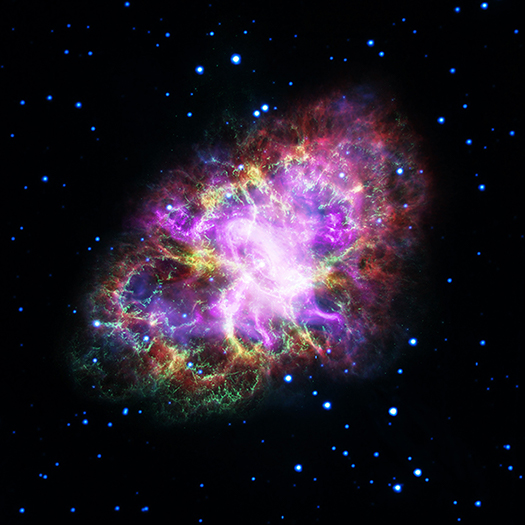
The Crab Nebula
Astronomers have produced a highly detailed image of the Crab Nebula, by combining data from telescopes spanning nearly the entire breadth of the electromagnetic spectrum, from radio waves seen by the Karl G. Jansky Very Large Array (VLA) to the powerful X-ray glow as seen by the orbiting Chandra X-ray Observatory. And, in between, the Hubble Space Telescope's crisp visible-light view and the infrared perspective of the Spitzer Space Telescope.
The Crab Nebula, the result of a bright supernova explosion seen by Chinese and other astronomers in the year 1054, is 6,500 light-years from Earth. At its center is a super-dense neutron star, rotating once every 33 milliseconds, shooting out rotating lighthouse-like beams of radio waves and light — a pulsar. The nebula's intricate shape is caused by a complex interplay of the pulsar, a fast-moving wind of particles coming from the pulsar, and material originally ejected by the supernova explosion and by the star itself before the explosion.
This image combines data from five different telescopes: The VLA (radio) in red; Spitzer Space Telescope (infrared) in yellow; Hubble Space Telescope (visible) in green; XMM-Newton (ultraviolet) in blue; and Chandra X-ray Observatory (X-ray) in purple.


